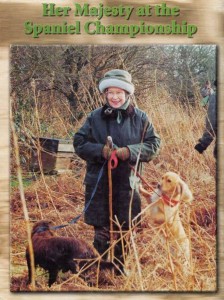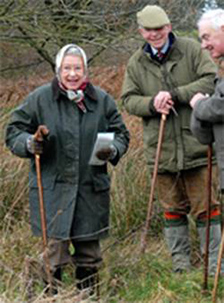Interview with David Lauber – Part II
(With permission. Originally published on www.gundogsonline.com)
Last issue we spent time talking with David Lauber in regards to beginning the steadying process in the yard. This issue we will continue our talk and move on to the steadying process in the field.
 “As I mentioned last month… The steadying process is not black and white. It’s filled with many gray areas that require a person with knowledge and experience.I have seen many dogs ruined by novice trainers because they lack the experience required to read the dog properly and apply the techniques outlined here. The steadying process, which I explain here, is only one approach. An entire book could be written to address all the issues you could run into during the steadying process and how to combat the “steadying blues”. When professionals train dogs they try many different approaches before they find an approach that works with a particular dog. A reputable professional can read a dog and avoid problems long before they actually occur. This is where the experience of professional trainers comes into play. By constantly refining their training program, professional trainers can often avoid the inevitable pitfalls novice run into when training a dog. A well thought out training program, built on experience, can often be the difference that makes or breaks a field trial champion and even a gun dog as we move into the advanced levels of training. ”
“As I mentioned last month… The steadying process is not black and white. It’s filled with many gray areas that require a person with knowledge and experience.I have seen many dogs ruined by novice trainers because they lack the experience required to read the dog properly and apply the techniques outlined here. The steadying process, which I explain here, is only one approach. An entire book could be written to address all the issues you could run into during the steadying process and how to combat the “steadying blues”. When professionals train dogs they try many different approaches before they find an approach that works with a particular dog. A reputable professional can read a dog and avoid problems long before they actually occur. This is where the experience of professional trainers comes into play. By constantly refining their training program, professional trainers can often avoid the inevitable pitfalls novice run into when training a dog. A well thought out training program, built on experience, can often be the difference that makes or breaks a field trial champion and even a gun dog as we move into the advanced levels of training. ”
Gundogs Online:
“Last month we finished the conversation with steadying the dog in the yard with bumpers. How do you introduce birds into the steadying process?”
David Lauber:
“We have to realize that a dog will be more tempted to break once we move to birds. Therefore, we don’t want to introduce birds into the steadying process until the dog is solid on bumpers.”
“Once our spaniel is consistent on bumpers we must start the whole process over, but this time with clip wing pigeons. During the first phase, we taught the dog what we expect; now we want to increase the temptation level by introducing birds and test what has already been taught. It’s not really any different than any other training concept.”
“We step back to the point where we were throwing the bumper over our shoulder, with the rope wrapped around one pole, making sure we give ourselves enough rope to maneuver. We then step back five or six yards, so we are positioned in front of the canine, while holding the other end of the rope in one hand. Now it is time to hit the whistle, giving him the “hup” command and toss the clip wing pigeon over our shoulder. Then we give him the release command once the bird has hit the ground.”
“The same rules apply regarding the amount of time we hold our dog before sending him for the retrieve. When we first start teaching the concept we are not concerned with the interval of time that goes by before sending him. All we are looking for is that he waits until he is sent to make the retrieve. Gradually, we will want to mix-up the cadence so he does not begin to anticipate the release command and start leaving before being sent.”
“We do this until we feel confident that he will wait until he is sent to make the retrieve. Then we remove the poles from the concept and have the dog sit off to the side of us once again and throw the bird in front of the dog.”
“Once we feel he is reliable while he is sitting off to the side of us, we set up the concept so the dog is between us and the bird. We do this by calling the dog toward us, then we hit the “hup” whistle and throw the bird over the dog’s head. This is where it gets interesting. Remember, the dog is now between the bird and us. Every bit of temptation is right there in front of him. Up until this point the dog may not have made an attempt at breaking because we have always been right there to intervene. Now that he is closer to the bird then we are, he just might make a run at it. The only thing we can do if he breaks is hold onto the check cord and stop him. We don’t want him getting the bird if we can help it.”
Gundogs Online:
“Once we have the dog steady in the yard, how do we transition the dog into the field?”
David Lauber:
“The process of transitioning a spaniel from steadying in the yard to steadying in the field is a slow process. This phase is going to be very tempting to the dog, so go slow. We don’t want to lose our patience. The last thing we want to do at this point is start off with flying birds, we again need to step back and apply the concepts he has learned in the yard to the field.”
“We start by heading to the field and having him quartering again, picking up clip wing pigeons. It helps to have a couple gunners helping out at this point. Once we think he is about ready for a test, we would let him get out to the wing gunner and hit the “hup” whistle and while we throw a clip wing pigeon behind us. Sometimes they stop, sometimes they don’t. If he doesn’t even think about sitting down, we know he is not ready to be steady in the field yet. However, if he hesitates and then continues on, we would want to start thinking about going out there, picking him up and sitting him back at the place where he was when we hit the whistle. I probably would not do this right away; I would first let him get accustomed to knowing what we expect in the field. Then start to apply this type of correction. There needs to be a slow transition from the yard to the field. If we come down on him right away he may start to get confused and shut down on us.”
“The next step is to have the gunners start throwing clip wings for us. It’s important that we are in sync with the gunner; otherwise we might start hitting the whistle when the bird is not in the air. Many times our back will be to the gunner, so we can stop the dog if he tries to break. So we might not know exactly when the bird is in the air. This is where communication between the handler and the gunners is important. Ideally, we want to hit the whistle as the bird is thrown into the air. If the gunners give a “hey…hey…hey” as they start to throw the bird, no matter what position we are in, we know that if the gunner gives a “hey…hey…hey” the bird is being thrown. However, I always like to start by first throwing the bird myself so I can be assured of the correct timing and send the message loud and clear to the dog.”
“Additionally, I like to have the check cord on the dog so that the gunner can step on it if the dog does break, or if the dog gets past us we can step on the rope before he gets to the bird. The primary objective here is not to let him get the bird until he is sent. If he gets the bird when he has not been sent, it will set us back several weeks, in most cases.”
 Gundogs Online:
Gundogs Online:
“What type of correction should you give the dog if he does not respond to the “hup” command?”
David Lauber:
“Well, that depends on where we are in the training process. In the beginning, I might stop him with the check cord and pick the bird up myself. We have to remember we are dealing with a young dog. If we are at a point where the dog knows he is not suppose to go until he is sent, but hesitates and still goes, we would set him back to the place where we hit the whistle and then go pick up the bird ourselves.”
“Also, from the beginning I like to have the dog sitting down, not standing to their birds. When they are standing, they are one step closer to breaking on us. So, I prefer to have them sitting. In fact, I have seen some dogs that are allowed to stand their birds and actually have one foot in the air. They are about a half a step from breaking…”
“Knowing when and what type of correction to apply on a dog if he breaks is very important. This is the time when we can make or break the dog, and one area where the assistance of a professional trainer is well worth the money. I have seen more dogs ruined by amateurs who have applied an improper correction to the dog during this phase. We have to check our ego at the door and be patient with the dog. If we feel ourselves losing our temper, we should put the dog up and try again later.”
Gundogs Online:
“When do you start giving the dog flyers and start shooting over him or her?”
David Lauber:
“We should not be giving the dog any flying birds until the dog is 95-100% steady on hand thrown clip wings. Then and only then, should we work the dog on flying birds.”
“At this point we need to really know our team. As a handler we need to communicate with the gunners not to throw the bird until we signal them. For example, while the dog is quartering we might tell the gunner, “Next time, throw it on my signal”. It’s all about timing. It’s very critical that everybody knows what he or she is doing. We will start this process by throwing the birds from hand then moving to rolling birds in for the dog. When we first start giving the dog flyers, we don’t want to miss any birds. We want to get all the birds down so that we can reward him for steadying to the bird. This is where a handler needs to know his guns. The number one goal here is to get the bird down so the dog gets the retrieve.”
“If the dog is solid on all the steps prior to this step, he should not have much problem with this phase. If he does, simply step back and review the previous step. All these steps build on themselves. If there is a problem, it probably showed itself in some form or another in the previous steps.”



